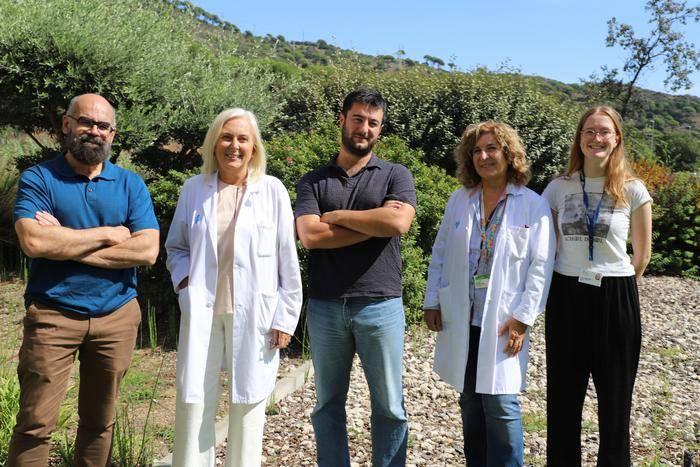Researchers have discovered a potential breakthrough in multiple sclerosis treatment by combining cell therapy with an existing drug.
Summary: A study published in the Journal of Clinical Investigation reveals that combining tolerogenic dendritic cells with dimethyl fumarate could offer a more effective treatment for multiple sclerosis than current options.
Estimated reading time: 6 minutes
Multiple sclerosis (MS) affects millions worldwide, causing progressive disability as the immune system mistakenly attacks the protective myelin sheath around nerve cells. Current treatments often suppress the entire immune system, leaving patients vulnerable to infections and cancer. Now, a groundbreaking study led by researchers from the Josep Carreras Leukaemia Research Institute and the Germans Trias i Pujol Research Institute offers hope for a more targeted approach.
The research, published in the Journal of Clinical Investigation, explores the potential of combining cell therapy using tolerogenic dendritic cells (tolDCs) with dimethyl fumarate, an existing MS drug. This novel approach could revolutionize MS treatment by addressing the root cause of the disease without compromising overall immune function.
Understanding the Challenge: Dysfunctional Immune Cells in MS
The study focused on a promising cell therapy using tolerogenic dendritic cells (tolDCs), which are designed to restore immune balance without suppressing the entire immune system. However, researchers faced a significant hurdle: the very immune cells needed for this therapy are often dysfunctional in MS patients.
To investigate this issue, the team examined three types of cells from untreated MS patients and healthy individuals:
- CD14+ monocytes
- Mature dendritic cells (mDCs)
- Vitamin D3-treated tolerogenic dendritic cells (VitD3-tolDCs)
Their findings revealed that cells from MS patients exhibited a persistent “pro-inflammatory” signature, even after being transformed into VitD3-tolDCs. This inflammatory tendency made the cells less effective as a therapeutic tool compared to those derived from healthy individuals.
Restoring Cell Function: The Role of the Aryl Hydrocarbon Receptor
Using advanced research methodologies, the team identified a key pathway linked to the altered immune response in MS patients: the Aryl Hydrocarbon Receptor (AhR). This discovery led to a crucial breakthrough.
By modulating the AhR pathway, researchers were able to restore the normal function of VitD3-tolDCs from MS patients in laboratory settings. Importantly, they found that dimethyl fumarate, an already approved MS drug, could mimic this effect and restore the cells’ full efficacy with a safer toxicity profile.
Promising Results in Animal Models
To further validate their findings, the research team conducted studies using experimental autoimmune encephalomyelitis (EAE), an animal model of MS. The results were striking:
- The combination of VitD3-tolDCs and dimethyl fumarate led to better outcomes than either treatment alone.
- This combined therapy significantly reduced symptoms in mice with EAE.
These findings suggest that the combination approach could offer enhanced therapeutic potential for human MS patients.
Implications for Future MS Treatment
This research represents a significant step forward in developing personalized cell therapies for autoimmune diseases. By combining tolDCs with dimethyl fumarate, doctors may be able to offer MS patients a more effective treatment option that:
- Targets the root cause of the disease
- Restores immune balance without general suppression
- Potentially slows or halts disease progression more effectively than current treatments
The study’s findings could lead to new clinical trials exploring this combined therapy approach, offering hope to millions of MS patients worldwide.
Questions and Considerations
While the results are promising, several questions remain:
- How will this combined therapy perform in human clinical trials?
- What are the long-term effects of this treatment approach?
- Could this method be applied to other autoimmune diseases?
As research progresses, these questions will need to be addressed to fully understand the potential of this novel treatment strategy.
The study represents a collaborative effort, partly funded by public grants from the Spanish Government (ISCIII, FEDER, and MICINN) and the EU Horizon program (INsTRuCT and RESTORE projects). As the scientific community continues to explore innovative approaches to MS treatment, this research offers a glimpse into a future where personalized, targeted therapies could transform the lives of those living with this challenging disease.
Quiz: Test Your Knowledge
- What cell type is the focus of the new therapy approach in this study? a) T cells b) B cells c) Tolerogenic dendritic cells d) Natural killer cells
- Which existing MS drug was found to restore the function of cells from MS patients? a) Interferon beta b) Dimethyl fumarate c) Glatiramer acetate d) Natalizumab
- What receptor pathway was identified as key to the altered immune response in MS patients? a) Toll-like receptor b) T cell receptor c) Aryl hydrocarbon receptor d) Interleukin receptor
Answers:
- c) Tolerogenic dendritic cells
- b) Dimethyl fumarate
- c) Aryl hydrocarbon receptor
Further Reading
- Original research paper in Journal of Clinical Investigation
- Josep Carreras Leukaemia Research Institute
- Germans Trias i Pujol Research Institute
Glossary of Terms
- Multiple Sclerosis (MS): A chronic disease where the immune system attacks the protective layer around nerve cells.
- Tolerogenic dendritic cells (tolDCs): Immune cells that can help restore balance to the immune system without causing general suppression.
- Myelin sheath: The protective covering around nerve fibers that is damaged in MS.
- Aryl Hydrocarbon Receptor (AhR): A cellular pathway linked to immune response regulation.
- Dimethyl Fumarate: An approved drug for treating MS that was found to restore cell function in this study.
- Experimental autoimmune encephalomyelitis (EAE): An animal model used to study MS.
Enjoy this story? Get our newsletter! https://scienceblog.substack.com/
If our reporting has informed or inspired you, please consider making a donation. Every contribution, no matter the size, empowers us to continue delivering accurate, engaging, and trustworthy science and medical news. Independent journalism requires time, effort, and resources—your support ensures we can keep uncovering the stories that matter most to you.
Join us in making knowledge accessible and impactful. Thank you for standing with us!

